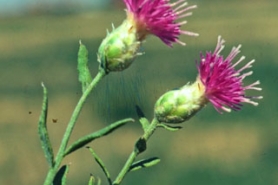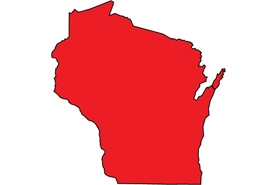Russian knapweed
(Centaurea repens)
A long-lived perennial plant with black rhizomatous roots that grow up to three feet in height and forms dense colonies.
Other names for this plant include:
- Common names: Turestan thistle, creeping knapweed, mountain bluet, Russian cornflower, hardheads
- Scientific names: Acroptilon repens, Rhaponticum repens, Centaurea picris
Classification in Wisconsin: Prohibited
- Ecological Threat
-
- Invades open grasslands, prairies, orchards and disturbed areas such as ditches, cultivated fields and field edges. Also commonly found near water sources such as river bottoms and irrigated areas.
- Aggressively outcompetes native vegetation, reducing overall biodiversity.
- Produces allelopathic compounds (toxic chemicals) that inhibit the establishment of other vegetation.
- Plants are easily spread by human activity via seed or root fragments.
- Plants are toxic to horses and reduce forage quality.
- Identification
-
Leaves & stems: Stems are thin and branching growing 18-26 inches tall. Younger stems have woolly hairs that decrease with age. Leaves are grayish-white and deeply lobed near the base; entire or serrate leaves occur on the upper branches.
Flowers: Pink to purple flowers emerge from silver-strawberry-colored buds. Urn-shaped single flower heads occur at the tip of individual branches. Floral bracts are green at the base and slightly hairy at the tip, with no fringes or spines.
Fruits & seeds: Ivory-colored achenes (single seeds) have tufts of hair that drop off at maturity.
Roots: Deep taproot with black lateral roots that give rise to new plants. Vertical roots can reach depths of over eight feet.
Similar species: Russian knapweed can be distinguished from other knapweeds by its black rhizomatous roots instead of taproot and floral bracts. Visit the Resources tab for more information.
- Control
-
In many cases, a combination of treatment regimes is the most effective approach to control. Reseeding with desired vegetation is critical to increasing treatment efficacy. Because Russian knapweed contains allelopathic compounds, plant debris must be removed to facilitate revegetation.
Mechanical- Russian knapweed does not tolerate dense shade. Shading out vegetation or laying off black landscape fabric is an effective control method.
- Continual cutting or hand pulling can slow plant growth and seed development, gradually decreasing plant root reserves. A single mowing treatment can initially increase plant densities. Digging is easiest in moist soils to remove the entire taproot. Otherwise, plants will resprout. Plants quickly reproduce by root fragments; therefore, tilling is not recommended as it most often spreads the infestation. Always manually control before seed-set. Bag and dispose of plants. Composting or burning is also a disposal option, but this does not destroy seed viability.
- Grazing by sheep and goats also suppresses knapweeds; however, animals only select knapweeds when no other vegetation is present.
Herbicide treatments are most effective when followed by reseeding and combined with other control techniques. The timing of herbicide treatments is essential to their effectiveness. Russian knapweed is most susceptible to herbicides in fall around the time of the first significant frost when herbicides will be translocated into the root systems.
- Clopyralid + 2,4-D at three to four quarts/acre applied during the bud-flowering stage or fall regrowth.
- Aminopyralid (Milestone®) at five to seven fluid ounces/acre applied during early bud to the flowering stage or resprouts in fall.
- Triclopyr + clopyralid (Redeem R&P®) at three to four pints/acre applied during the flowering stage or fall regrowth.
- Picloram (Tordon 22K®) is applied at a rate of two to four pints/acre during the bud-flowering stage or fall regrowth.
- Clopyralid (Transline® or Stinger®) was applied during the bud stage at a rate of 0.25-0.5 lb ae/acre (0.66-1.33pints/acre).
- A single application of glyphosate has been shown to increase growth.
- Resources
- Sources for content:
- Knapweeds (Spotted, Diffuse, & Russian) - Noxious Weed Integrated Vegetation Management Guide, IPM Practitioners Association.
- Montana State University Extension: Biology, Ecology, and Management of Montana Knapweeds; Knapweed Identification Monthy Weed Report, 2011.
- Center for Invasive Species and Ecosystem Health; Invasive.org


